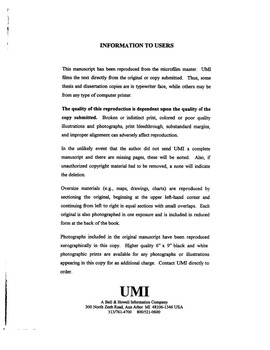| dc.contributor.advisor | Hobbs, Catherine, | en_US |
| dc.contributor.author | Cobb, Amanda Jane. | en_US |
| dc.date.accessioned | 2013-08-16T12:29:49Z | |
| dc.date.available | 2013-08-16T12:29:49Z | |
| dc.date.issued | 1997 | en_US |
| dc.identifier.uri | https://hdl.handle.net/11244/5524 | |
| dc.description.abstract | This project examines the literacy curriculum of the Bloomfield Academy for Chickasaw Females, a boarding academy established by the Chickasaw tribe in conjunction with missionaries. The school is unique in that the Chickasaw girls were not forced to attend one of the many federally run boarding schools in operation during the period of strict assimilation policies in U. S. history. Instead, the Chickasaw tribe, knowing that education was crucial to their survival as a nation, established a school system for their children for the purpose of assimilation, which became, in effect, a method of self-preservation. | en_US |
| dc.description.abstract | The chief objective under every administration was acculturation; however, each administration wanted the students to acculturate for different reasons. Missionaries provided religious literacy training to "civilize and convert" the tribe; the federal government saw literacy education as a way to make "efficient U. S. citizens" of the students and saw domestic literacy as the appropriate curriculum. The Chickasaws, however, knew that economic success, necessary for their survival as a nation, could not be achieved without literacy education. The tribe found it necessary to acculturate in order to compete and emphasized social literacy to train women to become educated and refined--leaders in the tribe and wives of leaders who could help them compete economically and socially in a "white world." Literacy, for the Chickasaw tribe, was a weapon used defensively and offensively in the fight for national survival and preservation. | en_US |
| dc.description.abstract | In its history as a boarding academy for girls, Bloomfield/Carter had three different administrations: mission, tribal, and federal. Each provided literacy instruction to achieve specific objectives and consequently, changed the literacy curricula of the school in whatever way would help them achieve those goals. I identify four major types of literacy curricula or literacy strands offered under each administration: academic, social, religious, and domestic. The type of literacy curriculum most emphasized under each administration indicates what sort of lives the students were being prepared to lead and why. Using both archival and ethnographic methods, I analyze the literacy curriculum offered under each administration and the purposes and implications of those curricula. | en_US |
| dc.format.extent | ix, 287 leaves : | en_US |
| dc.subject | Chickasaw Indians Education. | en_US |
| dc.subject | Bloomfield Academy for Chickasaw Females. | en_US |
| dc.subject | Education, History of. | en_US |
| dc.subject | Literacy Oklahoma History. | en_US |
| dc.subject | History, United States. | en_US |
| dc.subject | Education, Bilingual and Multicultural. | en_US |
| dc.subject | Sociology, Ethnic and Racial Studies. | en_US |
| dc.subject | American Studies. | en_US |
| dc.subject | Carter Seminary (Ardmore, Okla.) | en_US |
| dc.subject | Education, Language and Literature. | en_US |
| dc.title | Listening to our grandmothers' stories: An historical analysis of the literacy curricula at Bloomfield Academy/Carter Seminary for Chickasaw Females, Indian Territory/Oklahoma, 1852-1949. | en_US |
| dc.type | Thesis | en_US |
| dc.thesis.degree | Ph.D. | en_US |
| dc.thesis.degreeDiscipline | Department of English | en_US |
| dc.note | Director: Catherine Hobbs. | en_US |
| dc.note | Source: Dissertation Abstracts International, Volume: 58-08, Section: A, page: 3043. | en_US |
| ou.identifier | (UMI)AAI9806317 | en_US |
| ou.group | College of Arts and Sciences::Department of English | |
